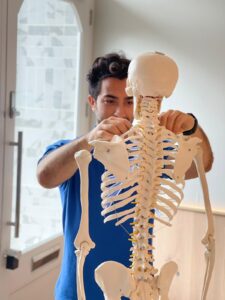 It is normal, as a runner, to experience some pain at some point. What is not normal is when this pain becomes chronic or a recurrent injury. The current medical evidence suggests that almost half of non-professional runners get a recurrent injury, mainly affecting their knees, calves and ankles. In this article, our Senior Osteopath & Medical Acupuncturist, Marco Antonetto, provides his top 5 tips to reduce the risk of running injuries.
It is normal, as a runner, to experience some pain at some point. What is not normal is when this pain becomes chronic or a recurrent injury. The current medical evidence suggests that almost half of non-professional runners get a recurrent injury, mainly affecting their knees, calves and ankles. In this article, our Senior Osteopath & Medical Acupuncturist, Marco Antonetto, provides his top 5 tips to reduce the risk of running injuries.
Is it the shoes we wear or the poor technique? Or do we keep neglecting strengthening and conditioning?
The truth: It could be one or all of these things. The good news is that most experts agree that to lower injury risk, you need not a magic bullet but a loaded gun to avoid running injuries. By this, we mean a combination of techniques and practices.
Don’t skip strength training. One of the best tips is to build a strong and conditioned body. Strong muscles, ligaments, and tendons guard against impact, improve form, and lead to a consistent gait.
Examples of strength training range from weightlifting to plyometric exercises such as box jumps and squats. Developing a full-body workout plan can help you stay conditioned year-round to avoid costly injuries that could sideline your running dreams.
Get a tailored program; don’t ask Dr Google. An effective plan might incorporate flexibility and mobility work, dynamic warmups and strength and core stability exercises. But remember, to be effective, the plan must be tailored to the individual and prescribed by a professional. What works for others might not work for you.
Power is nothing without flexibility and control! Incorporating stretching into your daily routine (not just when you run) is essential if you want to avoid running injuries and maximize your power.
Power without flexibility and control is nothing, so it’s important to make some time in your day to perform a few simple stretches. Some of the most important areas for runners to focus on are the hamstrings and hip flexors, but other areas like shoulders, arms, abs and back muscles should not be forgotten.
Performing these stretches daily will ensure greater flexibility, which will help avoid injuries.
Incorporate self-release techniques into your running routine. Stretching, foam rolling, and dynamic warmups are just some techniques that can be used before and after a run.
When done properly and consistently, these activities can help reduce inflammation in muscles and increase flexibility, allowing you to run longer distances with less pain and discomfort.
Your physical therapist can show you how to self-release selective areas of your body and prevent the build-up of tension and biomechanical dysfunction.
Prevention is the key! Get a physical assessment. This is the best way to detect if any discrepancies, weaknesses or biomechanics dysfunctions might lead to future injuries right from the very start.
Further reading
Running injuries can be inevitable for even the most experienced of athletes. As such, it is important to know how to avoid and manage them the best you can. Thankfully, it doesn’t have to be frustrating or daunting – we offer a range of articles on running and rehabilitation that explore the role of recovery in marathon training, helping you avoid running injuries and maximize your performance. So, if you’re looking to learn more about how to manage a running injury safely and effectively, make sure you check out our running series!
Nordic Balance offers 5-star-rated physiotherapy clinics in St James’s, Central London, Wimbledon and Clapham. For more information about the range of treatments, including physiotherapy, osteopathy, chiropractic, podiatry and sports massage, contact us.
January 27th 2021
As the crisp air signals the arrival of winter the mountains call out to skiing and snowboarding enthusiasts The thrill of gliding down snowy slopes is unmatched but it's accompanied by the risk of injuries that can dampen the spirit of the season By understanding the risks and preparing adequately...
READ MOREJanuary 27th 2021
If you're experiencing jaw pain clicking or difficulty chewing you might be a href https nordicbalance co uk temporomandibular what-is-tmj-causes-symptoms-when-to-seek-help dealing with Temporomandibular Joint TMJ dysfunction a TMD This condition can cause persistent discomfort tension headaches and restricted jaw movement The good news Simple physiotherapist-approved TMJ exercises for pain relief...
READ MOREJanuary 27th 2021
It is normal as a runner to experience some pain at some point What is not normal is when this pain becomes chronic or a recurrent injury The current medical evidence suggests that almost half of non-professional runners get a recurrent injury mainly affecting their knees calves and ankles In...
READ MORE